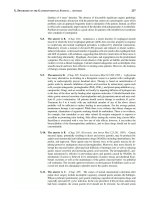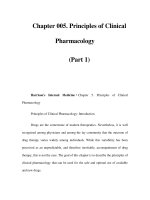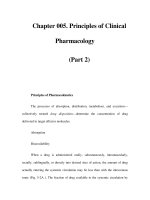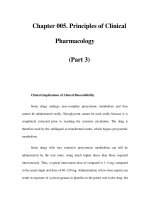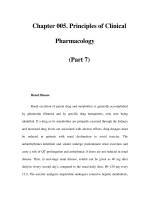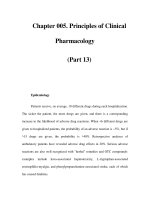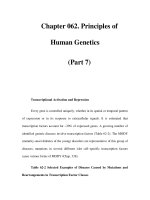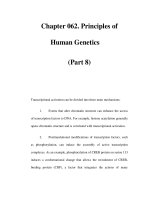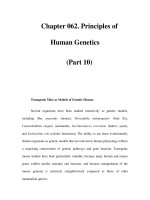Chapter 081. Principles of Cancer Treatment (Part 7) docx
Bạn đang xem bản rút gọn của tài liệu. Xem và tải ngay bản đầy đủ của tài liệu tại đây (14.03 KB, 5 trang )
Chapter 081. Principles of
Cancer Treatment
(Part 7)
Karnofsky was among the first to champion the evaluation of a
chemotherapeutic agent's benefit by carefully quantitating its effect on tumor size
and using these measurements to objectively decide the basis for further treatment
of a particular patient or further clinical evaluation of a drug's potential. A partial
response (PR) is defined conventionally as a decrease by at least 50% in a tumor's
bidimensional area; a complete response (CR) connotes disappearance of all
tumor; progression of disease signifies an increase in size of existing lesions by
>25% from baseline or best response or development of new lesions; and "stable"
disease fits into none of the above categories. Newer evaluation systems utilize
unidimensional measurement, but the intent is similar in rigorously defining
evidence for the activity of the agent in assessing its value to the patient.
If cure is not possible, chemotherapy may be undertaken with the goal of
palliating some aspect of the tumor's effect on the host. Common tumors that may
be meaningfully addressed with palliative intent are listed in Table 81-1, E.
Usually, tumor-related symptoms may manifest as pain, weight loss, or some local
symptom related to the tumor's effect on normal structures. Patients treated with
palliative intent should be aware of their diagnosis and the limitations of the
proposed treatments, have access to supportive care, and have suitable
"performance status," according to assessment algorithms such as the one
developed by Karnofsky or by the Eastern Cooperative Oncology Group (ECOG).
ECOG performance status 0 (PS0) patients are without symptoms; PS1 patients
have mild symptoms not requiring treatment; PS2, symptoms requiring some
treatment; PS3, disabling symptoms, but allowing ambulation for >50% of the
day; PS4, ambulation <50% of the day. Only PS0, PS1, and PS2 patients are
generally considered suitable for palliative (noncurative) treatment. If there is
curative potential, even poor-performance status patients may be treated, but their
prognosis is usually inferior to that of good-performance patients treated with
similar regimens.
An important perspective the primary care provider may bring to patients
and their families facing incurable cancer is that, given the limited value of
chemotherapeutic approaches at some point in the natural history, palliative care
or hospice-based approaches, with meticulous and ongoing attention to symptom
relief and with family, psychological, and spiritual support, should receive
prominent attention as a valuable therapeutic plan (Chap. 11). Optimizing the
quality of life rather than attempting to extend it becomes a valued intervention.
Patients facing the impending progression of disease in a life-threatening way
frequently choose to undertake toxic treatments of little to no potential value, and
support provided by the primary caregiver in accessing palliative and hospice-
based options can be critical in providing a basis for patients to make sensible
choices.
Cancer Drugs: Overview and Principles for Use
Cancer drug treatments are of four broad types. Conventional
chemotherapy agents were historically derived by the empirical observation that
these "small molecules" (generally with molecular weight <1500 Da) could cause
major regression of experimental tumors growing in animals. These agents mainly
target DNA structure or segregation of DNA as chromosomes in mitosis. Targeted
agents refer to small molecules or "biologicals" (generally macromolecules such
as antibodies or cytokines) designed and developed to interact with a defined
molecular target important in either maintaining the malignant state or selectively
expressed by the tumor cells. As described in Chapter 80, successful tumors have
activated biochemical pathways that lead to uncontrolled proliferation through the
action of, e.g., oncogene products, loss of cell cycle inhibitors, or loss of cell death
regulation, and have acquired the capacity to replicate chromosomes indefinitely,
invade, metastasize, and evade the immune system. Targeted therapies seek to
capitalize on the biology behind the aberrant cellular behavior as a basis for
therapeutic effects. Hormonal therapies (the first form of targeted therapy)
capitalize on the biochemical pathways underlying estrogen and androgen function
and action as a therapeutic basis for approaching patients with tumors of breast,
prostate, uterus, and ovarian origin. Biologic therapies are often macromolecules
that have a particular target (e.g., antigrowth factor or cytokine antibodies) or may
have the capacity to orchestrate or regulate the host immune response to kill tumor
cells. Thus, biologic therapies include not only antibodies but cytokines and gene
therapies.
The usefulness of any drug is governed by the extent to which a given dose
causes a useful result (therapeutic effect; in the case of anticancer agents, toxicity
to tumor cells) as opposed to a toxic effect. The therapeutic index is the degree of
separation between toxic and therapeutic doses. Really useful drugs have large
therapeutic indices, and this usually occurs when the drug target is expressed in
the disease-causing compartment as opposed to the normal compartment.
Classically, selective toxicity of an agent for an organ is governed by the
expression of an agent's target or by differential accumulation into or elimination
from compartments where toxicity is experienced or ameliorated, respectively.
Currently used chemotherapeutic agents have the unfortunate property that their
targets are present in both normal and tumor tissues. Therefore, they have
relatively narrow therapeutic indices.
